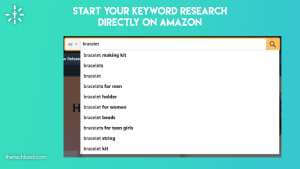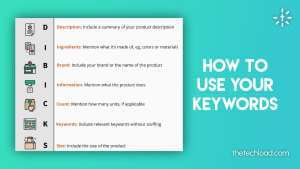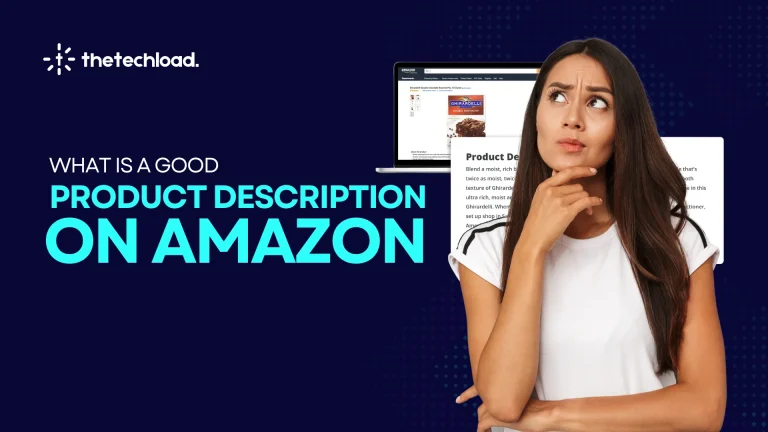Writing a good product description on Amazon is important for attracting customers and increasing sales. A good description gives buyers all the information they need about the product, helping them decide to buy it. But, many sellers find it hard to write descriptions that are interesting and follow Amazon’s rules. The problem is balancing detailed, persuasive information with Amazon’s rules. If descriptions are too promotional or poorly written, they can cause account issues. On the other hand, boring or unclear descriptions won’t turn visitors into buyers, leading to missed sales.
The solution is to write clear, simple, and rule-following descriptions. By focusing on relevant information and good formatting, you can create descriptions that grab customers’ attention and boost sales. Want to learn how to write the good product description on Amazon?
Keep reading for easy tips and strategies to improve your listings and succeed on Amazon.
What is Product Description on Amazon?
Product description on Amazon are key parts of your listings, offering detailed information to potential buyers.
Appearing below the product title, these descriptions can be up to 2000 characters long.
Their main purpose is to provide customers with the comprehensive details needed to make informed purchasing decisions.
The product title’s role is to grab attention and give a quick overview, while the good product description dives deeper into the product’s features and benefits.
Since online shoppers can’t physically inspect the products, the description acts as a substitute, offering vital information to help them understand the product better.
Effective product descriptions are key tools for enhancing both conversions and visibility on Amazon.
They should focus solely on the product, avoiding company information, promotional language, or URLs.
By providing clear, detailed, and relevant information, product description on Amazon can significantly boost a product’s appeal and performance on the platform.
The Importance of Product Description on Amazon
Crafting good Product Description on Amazon is vital for success as a seller on the platform. These descriptions play a crucial role in attracting customers, boosting sales, and enhancing the overall shopping experience.
Let’s delve into the key roles of well-crafted product description on Amazon.
1. They impact your visibility in Amazon’s search results
Well-written product description on Amazon can significantly impact your visibility.
By incorporating relevant keywords and providing detailed information about your product, you can improve your search engine optimization (SEO) and increase your chances of appearing higher in Amazon’s search results.
This increased visibility can lead to more clicks and ultimately more sales for your products.
2. They enhance the customer experience
According to a recent survey by PickFu, a whopping 87% of shoppers find product descriptions super important when buying on Amazon.
This shows just how crucial it is to have clear, detailed descriptions.
When you give customers all the info they need, you boost your chances of selling.
Plus, happy customers are more likely to leave great reviews, tell others about your products, and keep coming back for more, helping your Amazon business thrive in the long run.
What do Customers Look for in a Product Description on Amazon?
When customers visit Amazon to make a purchase, they rely heavily on product descriptions to make informed decisions.
Here’s what they typically look for:
1. Detailed Product Information:
Customers want to know exactly what they’re buying.

They look for detailed descriptions that cover key features, specifications, dimensions, materials, and any other relevant information.
Example: If a customer is purchasing a laptop, they’ll want to know details like processor speed, RAM capacity, screen size, and battery life.
2. Clear Images and Videos:
Visuals play a crucial role in the decision-making process.
Customers expect high-quality images and, if available, videos that showcase the product from different angles and demonstrate how it’s used.
Example: For a clothing item, customers want to see images of the front, back, and sides, as well as close-ups of any intricate details or patterns.
3. Usage Instructions and Tips:
Customers appreciate descriptions that include usage instructions, care guidelines, and any additional tips or recommendations for getting the most out of the product.
Example: If selling a kitchen appliance, including recipes or cooking tips can add value to the description and make the product more appealing.
4. Customer Reviews and Ratings:
Many customers rely on reviews and ratings from other buyers to gauge the quality and performance of the product.
They look for descriptions that incorporate customer feedback and address common questions or concerns.
Example: A good product description may include snippets of positive reviews or highlight the product’s average rating.
5. Compatibility and Versatility:
Customers want to know if the product will meet their specific needs or if it’s compatible with other items they own.
Descriptions that highlight compatibility with different devices or versatility in usage tend to attract more interest.
Example: If selling smartphone accessories, mentioning compatibility with various phone models can help customers make informed decisions.
6. Value Proposition and Unique Selling Points (USPs):
Customers look for descriptions that communicate the unique benefits and advantages of the product.
They want to understand what sets it apart from similar offerings on the market.
Example: Highlighting features like eco-friendliness, durability, or exclusive design elements can appeal to customers looking for specific qualities in a product.
By addressing these factors in your product descriptions, you can effectively meet the needs and expectations of potential buyers, leading to increased sales and customer satisfaction.
How to Write an Effective Product Description on Amazon
1. Incorporate Keywords
When selling on Amazon, visibility is crucial.
In fact, 66% of American consumers start their product research on Amazon, and most don’t go beyond the first page of results.
This highlights the importance of Amazon SEO in making sure your products get noticed.
Amazon’s search algorithm, known as A10, has a single goal: to show shoppers the products they’re most likely to buy.
Unlike traditional SEO, which considers various search intents, Amazon SEO treats every search as transactional.
This means that the algorithm prioritizes two main factors:
- Relevance
- Performance.
To optimize your Amazon product listings, keyword research is essential.
Keywords are the terms and phrases that shoppers use when searching for products on Amazon.
By strategically incorporating relevant keywords into your product titles, bullet points, and descriptions, you can improve your product’s visibility and chances of appearing higher in search results.
Remember, Amazon SEO is unique, and understanding the nuances of the A10 algorithm is crucial for success.
By focusing on relevance and performance and strategically using keywords, you can enhance your product’s discoverability and attract more potential buyers on Amazon.
Finding the Right Keywords
The most crucial part of the challenge is finding the right keywords.
Thorough research is vital for this process. Effective keywords should balance search volume and relevance to your product.
Identifying and incorporating these keywords can significantly improve the conversion rate on your product pages.
Start your keyword research directly on Amazon using the auto-fill feature.
Amazon’s search bar suggestions are based on shoppers’ search habits, making it an excellent starting point.
- Go to Amazon.com (or your target country’s subdomain) in incognito mode.
- Use the search bar to start typing the name of your product. Amazon will suggest additional words related to your primary word based on search habits.
- Continue with the name of your product followed by different letters of the alphabet. For example, typing “headphones a” will bring up different options than “headphones b”.

Example: Typing “running shoes” might bring up suggestions like “running shoes men,” “running shoes women,” “running shoes waterproof,” and so on.
This method is free and can give you a solid initial list.
Explore other keyword Research Tools
Additionally, you can explore other keyword research tools like Keyword Tool, which provides adequate results to get you started without a paid plan.
While primarily built for search engine marketing, it can be an excellent brainstorming tool for Amazon keywords.
Example: Searching “wireless earbuds” on Keyword Tool might reveal keywords like “wireless earbuds with noise cancellation,” “wireless earbuds for running,” and “wireless earbuds under $50.”
How to Use Your Keywords
Once you’ve identified your keywords, you can utilize them in three main areas on Amazon:
- In product title
- Product description
- In Seller Central (hidden keywords)

To help you create good Amazon product descriptions that convert, we’ll focus on using keywords in your product title and description.
Avoid black hat SEO practices like keyword stuffing when incorporating keywords into your Amazon product title and description.
Ensure that keywords are included naturally and relevantly.
Example: Instead of writing “Running shoes men women waterproof lightweight comfortable,” opt for “Lightweight Waterproof Running Shoes for Men and Women – Comfortable for All-Day Wear.”
When optimizing your Amazon product title, consider these elements:
- Description: Summarize your product.
- Ingredients: Mention materials or colors.
- Brand: Include your brand name or the product’s name.
- Information: State what the product does.
- Count: Specify the number of units, if applicable.
- Keywords: Incorporate relevant keywords.
- Size: Include the product size.
- Example: “Acme UltraFit Running Shoes – Lightweight, Waterproof, and Comfortable – Ideal for Men and Women, Available in Multiple Sizes and Colors.”
Best Practices for Using Keywords
- Avoid Keyword Stuffing: Include keywords naturally without overloading your title or description.
- Focus on Relevance: Ensure the keywords are directly related to your product.
- Update Regularly: Keyword trends can change, so periodically review and update your keywords to stay competitive.
Focus on Benefits
Emphasize the benefits of your product rather than just listing its features.
Customers want to know how your product will improve their lives or solve their problems.
Highlighting benefits helps customers visualize the value your product offers and increases their desire to make a purchase.
Example: Instead of stating “Made with durable materials,” emphasize the benefit by saying “Built to last, our running shoes provide unparalleled durability and comfort for your daily runs.”
Keep Your Text Clear and Concise
Ensure your product description is easy to read and understand by keeping it clear and concise.
Use short sentences and bullet points to break up the text and make it more scannable. Learn how to write effective Amazon Bullet points for your listings to understand the concept better.
Focus on conveying essential information in a straightforward manner.
Example: Use bullet points to highlight key features and benefits of the product, such as size, material, color options, and unique selling points.
Review the Competition
Analyze competitor product descriptions to identify areas for improvement and differentiation.
Pay attention to how they structure their descriptions, the language they use, and the features and benefits they highlight.
Use this information to refine your own product description and make it stand out from the competition.
Example: If competitors emphasize “comfort” in their running shoes, you could highlight an additional benefit like “breathability” or “enhanced arch support.”
Conclusion
In conclusion, crafting a good product description on Amazon is essential for success on the platform.
It not only informs customers about your product but also improves its discoverability in search results.
At TheTechLoad, we understand the importance of compelling product description on Amazon and can help you create content that resonates with your target audience.
Our team of experts can optimize your listings with engaging copy and relevant keywords, ensuring maximum visibility and conversion rates.
Let us help you elevate your Amazon presence with effective product descriptions that drive results.
FAQs
What length should an Amazon product description be?
Amazon allows up to 2000 characters for product descriptions. Use this space wisely to provide detailed and relevant information about your product, including features, benefits, and usage instructions.
How often should I update my product description on Amazon?
Regularly updating your product description on Amazon can help maintain their relevance and accuracy. Aim to review and update descriptions every few months or when there are changes to the product, market trends, or customer feedback.
Should I include pricing information in my Amazon product description?
No, pricing information should not be included in the product description on Amazon. Amazon handles pricing separately, and including it in the description can lead to inconsistencies and confusion if the price changes.
How can I track the effectiveness of my product description on Amazon?
You can track the effectiveness of your product descriptions on Amazon through Amazon Seller Central’s analytics tools. Monitor metrics such as conversion rates, page views, and customer feedback. A/B testing different versions of descriptions can also provide insights into what works best.
Are there any restrictions on the use of keywords in Amazon product descriptions?
Yes, Amazon has guidelines for keyword usage. Avoid keyword stuffing, and ensure keywords are relevant and used naturally. Always check Amazon’s latest policies, as certain terms and phrases are restricted to maintain compliance.






2 Responses